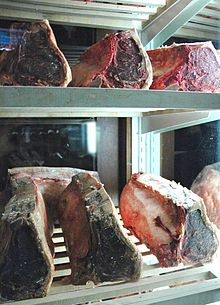Hanging out (cooking)


As meat maturation is called the controlled storage of raw meat , even of entire recessed slaughter animals (including wild game ), to improve the quality of meat.
Aim of meat maturation
Meat maturation is the controlled storage of raw meat. Meat becomes tough soon after slaughter and then has little taste. Only when it is properly stored and matured does it become tender, aromatic and digestible. Meat that has matured for a long time has a greater ability to bind water , it cooks faster and stays juicy. Meat maturation takes place within the muscle fibers and begins as soon as the still warm meat cools down directly after slaughter.
Two phases of meat maturation
Regardless of the maturation process, the meat maturation process takes place in two phases:
First phase of meat maturation
After slaughter, is soft and flabby muscles in the after some time rigor mortis about. Because the blood supply and thus the oxygen supply is interrupted with the slaughter , the metabolic processes in the meat now run under anaerobic conditions. The condition of the meat during rigor mortis is characterized by maximum firmness and minimal water-binding capacity. If you were to fry such a piece of meat, it would be very dry and tough and would have a strongly sour taste : it would be virtually inedible. The glycogen in the muscles is broken down into lactate over time . The resulting ATP ( adenosine triphosphate ) ensures that the muscle contraction subsides and the meat slowly becomes softer again.
Second phase of meat maturation
Due to the resulting lactate ( salt of lactic acid ), the pH value of the meat fell from over 7 to below 5.8 during slaughter. Nascent enzymes , eg. B. Cathepsine and Calpaine , cause the muscle fiber structures to dissolve and thus ensure an increasing tenderness. The water-binding capacity also increases again during the second phase of meat maturation. Depending on the type of meat ripening, the ripening process is now continued hanging on the bone or shrink-wrapped in vacuum packaging .
Types of meat ripening
Duration of meat maturation in different animal species
The time it takes for meat to mature depends on the type of animal: for poultry and pork it is usually up to three days, for veal up to a week, and for game and beef one and a half to two and a half weeks. In Germany, however, dry-aged beef is also available for five weeks.
See also
literature
- Richard Hering (†); F. Jürgen Herrmann (Editing / Ed.): Herings Lexicon of the Kitchen . 23rd, expanded edition. Fachbuchverlag Pfanneberg, Haan-Gruiten 2001, ISBN 3-8057-0470-4 .
- Hervé This-Benckhard : Riddles and Secrets of the Art of Cooking. Explained scientifically. Paperback special edition, 11th edition. Piper, Munich 2008, ISBN 978-3-492-23458-0 .
Web links
- Lebensmittellexikon.de: meat, slaughtered meat